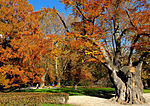Fallbach (Inn, Innsbruck)
Austria river stubsRivers of AustriaRivers of Tyrol (state)Tributaries of the InnTyrol geography stubs

The Fallbach is a small river in Tyrol, Austria, a tributary of the Inn. The Fallbach lies in full in Innsbruck's city area. It should not be confused with the similarly-named river, a left Inn tributary in Baumkirchen. The Fallbach has a length of 7 km (4.3 mi). It originates near the Gramart area on the Hungerburg at 900 metres (3,000 ft) above sea level. It runs straight in southern direction to St. Nikolaus where it merges with the Inn. The water of the river is collected in two artificial reservoirs and supplies the areas of St. Nikolaus and Höhenstraße with drinking water. This often causes locally low water levels in the Fallbach.
Excerpt from the Wikipedia article Fallbach (Inn, Innsbruck) (License: CC BY-SA 3.0, Authors, Images).Fallbach (Inn, Innsbruck)
Innstraße, Innsbruck Sankt Nikolaus (Innsbruck)
Geographical coordinates (GPS) Address Nearby Places Show on map
Geographical coordinates (GPS)
| Latitude | Longitude |
|---|---|
| N 47.2744 ° | E 11.3954 ° |
Address
Innstraße 42
6020 Innsbruck, Sankt Nikolaus (Innsbruck)
Tyrol, Austria
Open on Google Maps









